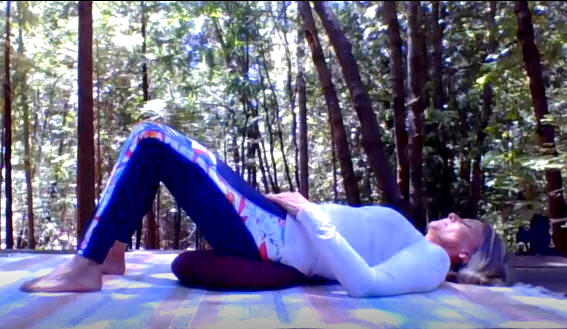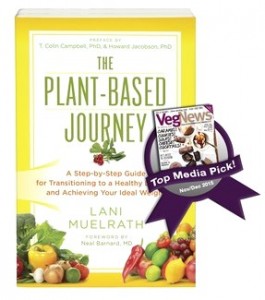 Restorative Yoga is a mindfulness-of-body practice that quickly counters stress and restores equanimity. The Supported Bridge is one of my favorites. What follows is the transcript of the video above.
Restorative Yoga is a mindfulness-of-body practice that quickly counters stress and restores equanimity. The Supported Bridge is one of my favorites. What follows is the transcript of the video above.
This video was created as a gift for pre-ordering The Mindful Vegan: A 30-Day Plan for Finding Health, Balance, Peace, and Happiness, and has just been released to the public.
The Supported Bridge Video Transcript:
Every one of us experiences occasional – if not regular – stress. And we all know how stress that has progressed to anxiety feels. Some people even experience anxiety as a daily – if not constant – companion.
You have probably heard of or read about how mindfulness-based meditation practices can soothe feelings of stress and anxiety. Being consciously aware that we are experiencing these emotions can help mitigate the experience of them while they are happening.
Before You Reach the End of Your Mental or Emotional Rope
Learning to bring conscious attention to the physical sensations of stress and anxiety can be extremely instrumental in helping us avoid suddenly finding ourselves at the end of our mental or emotional rope.
While we may not always be aware of it, our bodies always gives us notice as to what is happening mentally and emotionally. You may recognize your own manifestations of stress: shoulders hiked up to your ears, strain in your face or jaw, a knot in your gut.
These bodily sensations can show up anywhere in your body, and may be strong or they may be quite subtle. These signs can be going on largely undetected – sometimes until they reach a crisis point.
As you get to know the messages your body sends – through practices such as mindfulness of bodily sensations as I teach in The Mindful Vegan – you begin to recognize the early physical warning signs of stress. By becoming familiar with how your body exhibits signs of tension, you can move your awareness into these areas of tension and relax in pre-emptive fashion – before you feel like a nervous wreck.
Restorative Yoga
Restorative Yoga is a particularly healing branch of yoga practices that can give you an early entry point into the accumulation of stress. It can assist you in into dissolving the build up of anxiety from its stress origins to what can end up as a crippling anxiety experience.
If you are not familiar with Restorative Yoga, it is a deeply relaxing style of yoga practice that is receptive rather than active in nature.
Restorative Yoga poses are held from five to as long as twenty minutes, during which time you are held in comfortable “shapes” formed by pillows, blankets bolsters, or other props. The body is invited to relax into the shape in which it is being supported. These shapes achieve a desired benefit – whether it is opening up your lungs, releasing tension in the hips or back, or any of a variety of positions that invite you to simply relax into and let go into a state of balance that is very healing.
The Supported Bridge

One of my favorite moves for the Restorative Yoga process is the Supported Bridge. You may recognize The Bridge posture from regular yoga practice where the unsupported bridge is a very common position.
The supported bridge may look like it’s too simple to do much of anything. Yet remember, restorative yoga is a different animal than power yoga – and simple is the new advanced!
The secret of this move is in its ability to help you notice previously undetected physical warning signs of stress and anxiety. Practiced on a regular basis, it can also help to soothe your nervous system in general, thus serving as a stress and anxiety preventative.
How to Practice The Supported Bridge
- Lie down on the floor on your back with your knees bent and feet flat on the floor. Place a sturdy cushion, pillow, or folded blanket directly under your hips.
- Let your legs relax further by allowing the knees to drop toward each other.
- Your shoulders and head should be on the floor, your arms down by your sides, palms facing up. It is important to feel comfortable in this pose, so if it feels like your hips are elevated too high, creating discomfort in the lower back, use a thinner blanket or pillow.
- Allow the weight of your body to drop into the surfaces beneath you: the hips into the pillow or blanket the back, head, arms and bottoms of your feet melting into the floor and sinking into the blanket or cushion.
How to Bring Your Mind Along
As you let the body relax, you may find that your mind is reluctant to let go of its habit of dwelling on that which it is anxious about. We are far too practiced at mentally catastrophizing and simulating ‘what if’ scenarios.
To help you be present with this restorative practice, it can be helpful to give the mind something to do. As you continue to relax into the surfaces beneath you, gently bring your attention to any sensations in your body. You can do this quite effectively with a quick, gentle body survey, as I teach in The Mindful Vegan book. Start at the top of your head and move kindly through your body with your attention: down the sides and back of your head, the face, down the neck, shoulders and arms, to your hands. Then scan through your chest and back, down the torso, to your hips, thighs, and lower legs to your feet.
As you move through your body in this fashion, pay particular attention to areas that feel as if they are pushing up toward the ceiling or grasping in any way – these sensations flag the places where you may be holding tension. Observe these areas with curiosity and kindness. You may notice that simply by paying attention, there is a tension release. Observe those places that may have started out as tense. These are the areas of your body that will habitually become tense with stress, heralding the onset of anxiety.
With your mind attentive and your body relaxed, remain in Supported Bridge, if possible, for ten minutes or more. Even five minutes is well worth your while.
To come out of position, lift your hips, move the pillow or blanket beneath your hips to the side, and lower your hips to the floor. Lie flat on the floor for a few moments, noting any changes in how your body feels. Make note of any ways in which this posture altered your body and mood. In other words, directly experience the results of this brief, simple practice, so that you can draw upon it to repeat the posture in the future.
Bringing Some Degree of Mindfulness Forward Into Your Day
As you move to standing to go about your day, continue to observe whatever may have changed from before you moved into the Supported Bridge. Does your body feel more at ease? Is your breathing more relaxed? Are your usual “stress points” altered in any way?
You can go through this mindfulness of body practice daily, for longer than ten minutes if you’d like, and even before sleep at night. Like any conditioning, eventually it will alter your system, changing what has become a normal state of high alert to one of being more at ease, as well as allow you to become much more familiar with the territory of your body.
Knowing the body can be key to working with the mind, and with intention and kind attention, the body can become one of our greatest allies in alleviating our own experiences of stress and anxiety.
May your life be filled with greater ease,
,




Lani,
It has been such a stressful week for me that I decided to try this right away. It surprised me how simply getting into the position helped release the stress. I had no idea I was holding so much tension in my hips and back until you pointed it out to me with the move. I am wondering if this might not be something good to do every day? Thanks for this video, I bought The Mindful Vegan book just this week after hearing about it on the Plantbased Transformation summit so hadn’t heard about the pre-order before. It’s great that you published it now for all of us!
Cyb
Hi Cybil!
I am so happy to hear that you tried it right away! After all, it takes so little effort, simply grabbing a pillow and climbing onto a bed or laying down on the floor. I always feel deeply restored and relaxed from this simply position, and combine it with mindfulness of breath to really create a five minute mini-retreat pretty much any time during the day.
So glad you have The Mindful Vegan book! Hasn’t the PB Transformation Summit been great? Margot does such a good job.
Thanks for popping in to share, it means a lot!
Lani
Lani Muelrath,thanks so much for the post.Really thank you! Great.
This is one of my favorites too, Annie! Thank you for sharing in this way it is such a comforting and restorative Psalm. I often think of it with Spring 🙂
Hey Lani, thanks for the video. I never knew that Yoga can reduce our stees! I learned a lot of information after watching the video!